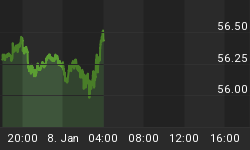Recently, I came across a stock market graph that blew my mind! It was while I was reading from H.M. Gartley's famous work, "Profits in the Stock Market," that I examined a chart of the stock market from 1936-1937. The chart contained great detail over these two years, spread out across three fold-out pages, and recorded the market at 20-minute intervals over these two years. What amazed me about this chart is that it seemed to reflect almost perfectly the scenario for 2003-2004 in the U.S. stock market. Since it would be impossible for me to reproduce this nearly 26-inch chart with a computer scanner, I took the liberty of reproducing by hand as best I could, this chart on graph paper. Here it is below.

Notice the dominant market low that occurred in April 1936, followed by a sustained and impressive advance all the way into November. At this point the market peaked and turned down into December of that year before bottoming above a major support area. Another rally phase was launched in late December 1936 that carried the market higher into March of 1937, at which point the market had a dominant peak and declined all the way into the end of June 1937. Then a secondary rally followed which led to a lower high in July-August, followed by another sharp drop into the fourth quarter of that year.
Now take another look at this chart, only replace the years 1936-1937 with 2003-2004 and I think you'll see much the same picture. Already, the year 2003 has turned out pretty much like 1936, save that the dominant low of this year was a month earlier(in March) than it was in 1936. Otherwise, the two markets of 1936 and 2003 took much the same path.
Just as the market of 1936 had a dominant interim low in December of that year, this year's market is due a dominant interim cycle bottom in late December, which, assuming it bottoms above the major near-term support area of the Dow, should lead to another impressive advance in early 2004 all the way to possibly April of next year (a month later than the 1937 peak, assuming it occurs). This assumption is based on the interaction of the dominant short-term cycles. At that point the effect of the 10-year cycle should be felt (which is due to bottom in late 2004), and this could create a drag on the stock market in the second half of next year similar to the way the market weakness felt in the second half of 1937. All of this is based on the assumption that history -- in varying degrees -- repeats itself over time.
Now let's switch gears a bit and go back even further to the early part of the 1930s, at around the time when the stock market made its final low after the 1929-1932 bear market. After confirming this dominant long-term low in 1933, the market proceeded to rally all the way up to 1937 (as mentioned above) before its next correction phase. What are the parallels between the 1930s and today. It should be very easy to see! We are exactly in the first decade of the 2000s where the market was at this time in the 1930s -- at the commencement of another bull market! Just as the stock market peak and depression of 70 years ago lasted 3 years (from 1929-1932), our most recent stock market peak (in 2000) and bear market low (October 2002, followed by confirmation in March 2003) was approximately 3 years. We've experienced a strong rally through most of 2003, just as the market of 1933 also rallied vigorously. The market is presently heading into the 10th year of its 10-year cycle (2004) just as it did in 1934. The 10-year cycle bottom was followed by an even more vigorous rally phase which led to higher highs being made in each successive year. If my calculations are correct, this should be true for the stock market in the next few years, especially once the 10-year cycle bottoms next year. In other words, the bear market is over for now and a new bull market phase has technically begun, one which could well lead to new all-time highs before it is over.
At the dominant low late last year a plethora of books with bearish themes made the best-seller lists, which from a contrarian standpoint marked a psychological low in the stock market. One of these books was "Conquer the Crash" by Robert Prechter. Within this book were a number of stunning charts from the 1930s, including several commodity charts, which all shows the bear market lows of 1932-33 and subsequent rally to 1936-37. Perhaps unintentionally, Mr. Prechter has provided us with a glimpse of what the coming 3-4 year period might unfold for us in stocks. Below is a hand-drawn sketch of the Dow Jones Industrial Average from the 1930s, which was also featured in his book. Note the similarities of 1932-33 to our own 2002-03 market. Then notice the overall lateral correction into the 10-year cycle low of 1934, followed by the breakout into near highs culminating in 1937.

We all know that history repeats, but do we really believe that? If so, I challenge you to look objectively at these charts and ask yourself if maybe history won't repeat again as it did in the 1930s. Time will tell. Also worth pointing out is that the 1930s were as bullish for commodities as well as stocks, including the metals, so there should be ample opportunities for making money in stocks as well as commodities in the coming years (i.e., hard assets as well as paper assets).
















